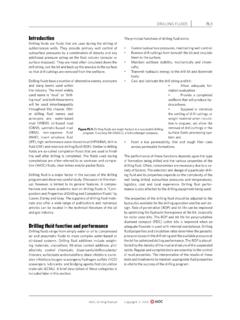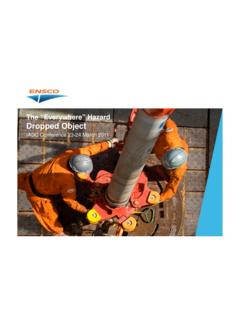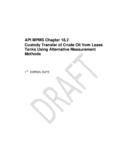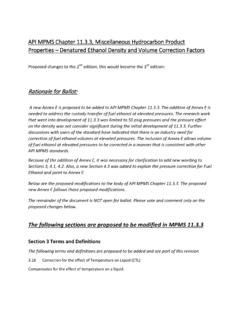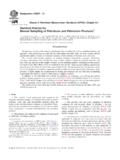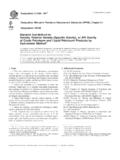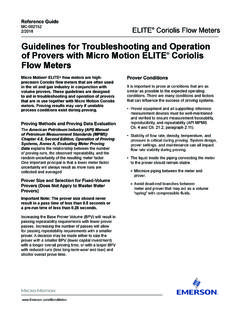Transcription of Introduction - IADC
1 Copyright 2015 CASING AND TUBINGCT-1 IADC Drilling ManualIntroductionTubulars are selected for the specific conditions anticipated in a given well. The anticipated production flow rates and economics of the well determine tubing size, which then de-termines the necessary size of each previous hole and tubu-lar. Once the tubular size and setting depths are determined, the wall thickness and grade of material are then chosen by the well designer to ensure the strength is adequate for the expected loads. Material grade is also selected to ensure it is appropriate for the fluids the tubular will encounter; cor-rosion resistant alloys (CRA) may be required in some envi-ronments such as CO2 or H2S.
2 Finally, tubular connections are selected based on dimensional needs, load capacity, and gas-vs-liquid chapter discusses types of casing and tubing; OCTG manufacturing, labeling and specifications; corrosion; API casing grades; transportation and handling; storage; and running typesThere are two basic types of pipes used in oil and gas ex-ploration and production and standardized by the American Petroleum Institute (API) and the International Standards Organization (ISO).For in-well services ( , below the wellhead oil country tu-bular goods [OCTG]): Casing: API 5CT/ISO 11960 with API 5B/ISO 10422 for threads; Tubing: API 5CT/ISO 11960 with API 5B/ISO 10422 for API, the specification differences between casing and tubing are: Length of the drift mandrel: 6 in.
3 Or 12 in. for casing and 42 in. for tubing; Joint strength calculation method: Minimum tensile strength for casing, and minimum yield strength for chapter specifically covers casing and tubing. For in-formation on drill pipe, heavyweight drill pipe and drill col-lars, please refer to the separate chapter Drillstring of the IADC Drilling Manual, 12th edition. For additional advice on drillpipe practices, refer to the separate chapter on Drilling of casing and tubingDrive, structural and conductor casingThe main purpose of this first string of pipe is to protect unconsolidated shallow formations from erosion by drilling fluids.
4 Additional functions of the first casing string include: Allows for installation of a full mud circulation system, when formations are sufficiently stable; Guides the drill string and subsequent casing into the hole; Can form a part of the piling system offshore for a wellhead jacket or piled platform. In subsea wells the conductor may form an integral part of the structural support for the wellhead system; Provide centralization for the inner casing strings, which limits potential buckling of subsequent casing strings; Minimize shallow lost returns; Provides a mount in onshore applications for a diverter system that would be used in the event of an unexpected shallow casings can be driven or jetted to depth or, alter-natively, run into a predrilled or jetted hole and casingSurface casing is installed to: Prevent poorly consolidated shallow formations from sloughing into the hole; Enable full mud circulation.
5 Protect fresh water sands from contamination by drilling mud; Provide protection against hydrocarbons found at shallow depths; Provide initial support for the blowout preventers; Provide kick resistance for deeper drilling; Support the wellhead system and all subsequent casing surface casing string is typically cemented to the sur-face or seabed. it is usually the first casing on which blowout preventers are installed. The amount of protection provided against internal pressure will only be as effective as the for-mation strength at the casing casingIntermediate casing is used to ensure there is adequate blowout protection for deeper drilling and to isolate forma-tions that could cause drilling problems.
6 The first intermedi-ate string is typically the first casing providing full blowout protection. An intermediate casing string is nearly always set in the transition zone associated with the onset of signif-icant overpressures. If the well could encounter severe lost circulation zone(s), intermediate casing would normally be set in a competent formation below the loss casing can also be used to case off any known hydrocarbon-bearing intervals as a contingency against the possibility of encountering lost circulation, with attendant well control problems. An intermediate string may also be set simply to reduce the overall cost of drilling and com-pleting the well by isolating intervals that have caused me-Copyright 2015 IADC Drilling ManualCT-2 CASING AND TUBING chanical problems in the past.
7 Intermediate casing may be required to isolate: Swelling clays and shale that can result in tight hole and key seats; Brittle caving shale or weak zones prone to washout and creation of persistent on bottom fill; Salt intervals; Chemically active formations that can upset mud chemistry; Over-pressured permeable formations; Hole sections that are used to deviate the wellbore; High permeability sand(s); Partly-depleted reservoirs that could cause differential good well designer should plan to combine as many of these objectives as possible when selecting a single cas-ing point. A liner may be used instead of a full intermediate casing string and difficult wells may actually contain several intermediate casings and/or linersA drilling liner is essentially a string of intermediate casing that does not extend all the way to surface.
8 It is hung off in or above the previous casing shoe and is usually cemented over its entire length to ensure it seals within the previous cas-ing string. In many subsea well designs, the liner is partially cemented around the shoe, and a liner lap packer is used to seal the liner top. This is necessary when the fracture gradi-ent cannot withstand the equivalent circulating density re-sulting from the pressure drops associated with cementing the entire liners may be installed to: Increase shoe strength to allow further mud density increases; Isolate troublesome zones; Satisfy rig tension load limitations; Minimize the length of reduced hole diameter to overcome possible adverse effects on drilling hydraulics and the size of drill pipe that can be used; Save money compared to running a full are a number of disadvantages to installing liners: Difficulty obtaining a quality cement job.
9 Risk of liner running equipment being cemented in the hole; The liner lap represents a potential source of influx and typically must be isolated by a retrievable bridge plug if it is necessary to remove the blowout preventer stack; The lap must be tested with both positive and negative pressure and remedial action taken if it fails to casing and tiebacksProduction casing is the conduit through which the well will be completed, produced and controlled throughout its life. On exploration wells, this life may amount to only a very short testing period, but on most development wells it will span many years, during which multiple repairs and recom-pletions might be performed.
10 Production casing should be designed to retain its integrity throughout its life. In most cases, production casing must provide full pressure redun-dancy to the tubing, isolate the productive intervals, facili-tate proper reservoir maintenance and/or prevent the influx of undesired size of the production casing is selected to accommo-date the optimum method of completion and production, along with: Well flow potential, , tubing size; Possibility of a multiple tubing string completion; Space required for downhole equipment, such as safety valves, artificial lift equipment, etc.; Potential well servicing and recompletion requirements; Adequate annular clearances to permit circulation at reasonable rates and is also possible that the production casing itself could be used as production tubing to maximize well deliverability (casing flow), to minimize the pressure losses during frac-ture stimulations, for continuous or batch chemical injection or for lift pipe centered in the annulus of an oil and/or gas well through which the hydrocarbons flow to the surface from the formation is called tubing.


